Monthly Archives: April 2025
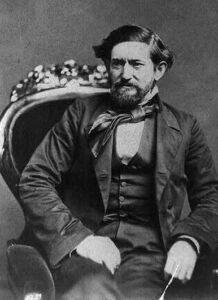
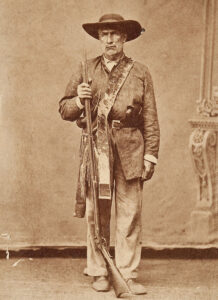 William Alexander Anderson Wallace was born in Lexington, Virginia on April 3, 1817, parents of Scots-Irish descent. He might have stayed in Virginia, but in 1836, when he was just 19 years old, Wallace received news that one of his brothers had been killed in the Battle of Goliad, which was an early confrontation in the Texan war of independence with Mexico. Wallace promised to “take pay of the Mexicans” for his brother’s death. So, with revenge on his mind, Wallace left Lexington and headed for Texas. Upon his arrival, Wallace found that the war was already over. With no further need of his anger-revenge agenda, Wallace found he liked the spirited independence of the new Republic of Texas and decided to stay.
William Alexander Anderson Wallace was born in Lexington, Virginia on April 3, 1817, parents of Scots-Irish descent. He might have stayed in Virginia, but in 1836, when he was just 19 years old, Wallace received news that one of his brothers had been killed in the Battle of Goliad, which was an early confrontation in the Texan war of independence with Mexico. Wallace promised to “take pay of the Mexicans” for his brother’s death. So, with revenge on his mind, Wallace left Lexington and headed for Texas. Upon his arrival, Wallace found that the war was already over. With no further need of his anger-revenge agenda, Wallace found he liked the spirited independence of the new Republic of Texas and decided to stay.
Wallace was a big man, standing over six feet tall and weighing around 240 pounds. His size alone made him an intimidating figure, but his nickname of “Big Foot” came from his unusually large feet. Wallace didn’t think he would ever get the chance to fight Mexicans, but in 1842, he finally got his chance when he joined with other Texans to stop an invasion by the Mexican General Adrian Woll. During another skirmish with Mexicans, Wallace was captured, and he spent the next two years serving hard time in the notoriously brutal Perote Prison in Vera Cruz. He was finally released in 1844.
After his time as a prisoner of war, Wallace returned to Texas and found himself feeling tired of the rigidness of the formal Texan military force. So, he decided to leave the military for the less rigid organization of the Texas Rangers. The Texas Ranger program was part law-enforcement officers and part soldiers. They fought both bandits and Native Americans in the large, but sparsely populated reaches of the Texan frontier. “Big Foot” Williams served under the famous Ranger John Coffee Hays until the start of the Civil War in 1861. Williams was against the idea of Texas secession from the Union, but he was unwilling to fight against his own people. He had really assimilated himself into Texas…it was a big part of him. Williams spent most of the Civil War defending Texas against Native American attacks along the frontier. He didn’t get involved in the “politics” of the matter, he just knew that he was now a Texan, and he had to defend her at all costs.
Wallace spent many years in the wilds of Texas, having hundreds of adventures. He was attacked by Native Americans while working as a stage driver on the dangerous San Antonio-El Paso route. In that event, he 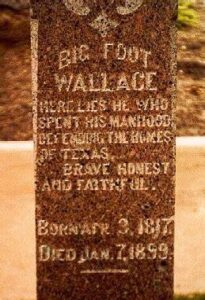
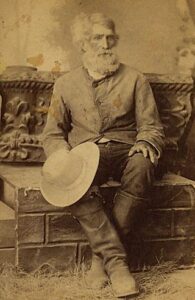 barely escaped with his life. The Natives stole his mules and left him stranded in the Texas desert. Forced to walk all the way to El Paso, he later said that he ate 27 eggs at the first house he came to after his long walk. Then, he went into town to have a “real meal.”
barely escaped with his life. The Natives stole his mules and left him stranded in the Texas desert. Forced to walk all the way to El Paso, he later said that he ate 27 eggs at the first house he came to after his long walk. Then, he went into town to have a “real meal.”
After many years and many adventures and in his old age, Wallace decided he had enough of life as a fighter and adventurer. He was tired and ready to learn how to relax. The state of Texas, in exchange for his years of service, granted Wallace land along the Medina River and in Frio County in the southern part of the state. Wallace loved to tell anyone who would listen, with highly embellished tales of his frontier days. Soon he became a well-known folk hero to the people of Texas. Wallace died on January 7, 1899. He is buried in the Texas State Cemetery.
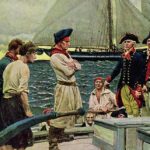
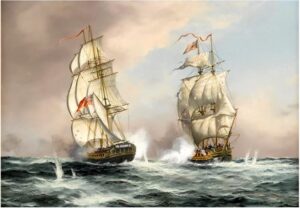 During the Revolutionary War, the United States, being a small start-up nation did not have huge amounts of funds to build a strong navy to fight against the influx of British ships sent to try to force our nation back under the rule of Great Britain, so being the resourceful nation they were, the Continental Congress made the decision to give privateers permission to attack any and all British ships on April 3, 1776. The bill was signed by John Hancock, president of the Continental Congress at that time. The bill issued “INSTRUCTIONS to the COMMANDERS of Private Ships or vessels of War, which shall have Commissions of Letters of Marque and Reprisal, authorizing them to make Captures of British Vessels and Cargoes.”
During the Revolutionary War, the United States, being a small start-up nation did not have huge amounts of funds to build a strong navy to fight against the influx of British ships sent to try to force our nation back under the rule of Great Britain, so being the resourceful nation they were, the Continental Congress made the decision to give privateers permission to attack any and all British ships on April 3, 1776. The bill was signed by John Hancock, president of the Continental Congress at that time. The bill issued “INSTRUCTIONS to the COMMANDERS of Private Ships or vessels of War, which shall have Commissions of Letters of Marque and Reprisal, authorizing them to make Captures of British Vessels and Cargoes.”
The private commercial ships were given “Letters of Marque and Reprisal” which were the official documents by which 18th-century governments commissioned private commercial ships, known as privateers, to act on their behalf. With these documents, they were officially allowed to start attacking ships carrying the flags of enemy nations. The motivation for the “assignments” was that any goods captured by the privateer were to be divided between the ship’s owner and the government that had issued the letter. It was a pretty good deal for the privateer, because they could then sell or use the good, or sell them for a profit. It was also a good deal for the government, because the received half of the “spoils” and they didn’t have to pay the privateer. As for the British ships…well, the deal was not so good.
The orders given to the privateers by Congress were “YOU may, by Force of Arms, attack, subdue, and take all Ships and other Vessels belonging to the Inhabitants of Great Britain, on the high seas, or between high-water and low-water Marks, except Ships and Vessels bringing Persons who intend to settle and reside in the United Colonies, or bringing Arms, Ammunition or Warlike Stores to the said Colonies, for the Use of such Inhabitants thereof as are Friends to the American Cause, which you shall suffer to pass unmolested, the Commanders thereof permitting a peaceable Search, and giving satisfactory Information of the Contents of the Ladings, and Destinations of the Voyages.”
The reality was that whether they were called privateers or pirates, the real distinction between the two was non-existent, at least to those who faced them on the high seas. The men were given the right to behave just 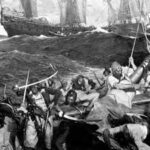
 like pirates, so they behaved just like pirates, boarding and capturing ships and using force if necessary. The good news for the privateers was that privateers holding Letters of Marque were not subject to prosecution by their home nation and, if captured, were treated as prisoners of war instead of criminals by foreign nations. Even if they were caught, this was the best-case scenario for the privateers, and they were the best thing for this country at that important time in our history.
like pirates, so they behaved just like pirates, boarding and capturing ships and using force if necessary. The good news for the privateers was that privateers holding Letters of Marque were not subject to prosecution by their home nation and, if captured, were treated as prisoners of war instead of criminals by foreign nations. Even if they were caught, this was the best-case scenario for the privateers, and they were the best thing for this country at that important time in our history.

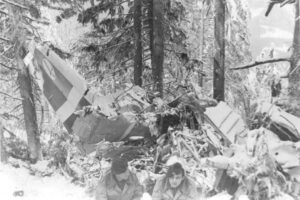 LOT Polish Airlines Flight 165 was a doomed Antonov AN-24 aircraft, registration SP-LTF. The plane operated as a scheduled passenger flight from Warsaw to Krakow Balice airport. Normally the 153-mile flight is a simple short hop, but on April 2, 1969, at 4:08pm local time the flight crashed into a mountain during a snowstorm. All 53 people on board were killed.
LOT Polish Airlines Flight 165 was a doomed Antonov AN-24 aircraft, registration SP-LTF. The plane operated as a scheduled passenger flight from Warsaw to Krakow Balice airport. Normally the 153-mile flight is a simple short hop, but on April 2, 1969, at 4:08pm local time the flight crashed into a mountain during a snowstorm. All 53 people on board were killed.
In 1969, crash investigation was not what it is today, and so a lot of the known information about the accident actually comes from two newspaper articles that were published in 1994. Of course, that doesn’t mean that no investigation took place, but from the sound of things, the documentation there has been kept classified according to the author who wrote that, “even 25 years after the accident, most documentation on the crash remains classified.” The information the author was able to gather came from the accounts of participants in the rescue action and some members of the accident investigation commission, but they asked for anonymity.
What is known and documented about the accident is that the aircraft took off from Warsaw at 3:20pm local time for a 55-minute flight to Krakow’s Balice Airport. The captain was Czeslaw Dolinski. The first officer received instructions at 3:49pm, to descend to 4,900 feet and to contact Balice control tower after passing Jedrzejów, which was less than 50 miles north of Krakow. At the time of the instructions, a military radar registered the aircraft at 13,000 feet. The pilots informed controllers in Okecie and Balice when the plane had passed the Jedrzejów VOR but there was some confusion when they provided three different passage times a few minutes apart. Shortly thereafter and before 4:00pm, the captain, who had taken over control at that point, called Balice. Dolinski gave his altitude as 12,100 feet, received the local weather report, and then was instructed to descend to 3,900 feet.
At 4:01pm, the aircraft was recorded at 7,900 feet and descending. Several radio exchanges took place between the place and the Balice radar operator over the next eight minutes, with the captain repeatedly asking for his fix and reporting problems with the beacon signal, and the operator asking for the aircraft’s position and altitude to help him find the aircraft on the radar screen. It was as if both the captain and the radar operator were confused as to where the plane was and at what altitude. At 4:05pm, the aircraft was noted near Maków Podhalanski, some 31 miles past Krakow…and at an altitude of 3,900 feet. The last transmission received from the airplane was, “Left turn to further…-” at 4:08.17pm. Seconds after that, radio contact was lost. It was at that moment that the plane crashed on the northern slope of Polica mountain, near Zawoja, southern Poland. the plane was located on the mountain side at an altitude of 3,900 feet.
The official death toll of 53 is still in question. The LOT Flight 165 manifest included 53 passengers and 5 crew members, but two days after the crash Polish press agencies published, 46 surnames, some without an address or name. According to the records, the passengers were 49 Poles, 3 Americans, and a Briton. The official 
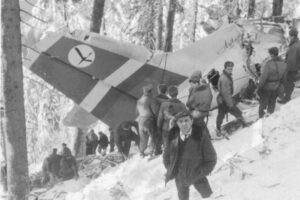 accident report, published in 1970, blamed the accident on the captain becoming lost. No one knew why the captain, just before the crash, was flying at low altitude some 31 miles past its intended destination. I don’t suppose it will ever be known for sure, or if it is, the fact that the documentation is classified will keep the truth from everyone anyway.
accident report, published in 1970, blamed the accident on the captain becoming lost. No one knew why the captain, just before the crash, was flying at low altitude some 31 miles past its intended destination. I don’t suppose it will ever be known for sure, or if it is, the fact that the documentation is classified will keep the truth from everyone anyway.

 Whether you or I prank anyone on this day makes no difference. This is the day for it. Why would anyone think that we need a day to be set aside whereby it was perfectly “legal” to play multiple tricks on people? Maybe they thought that after a long dreary winter, we needed a day to just get silly. Sounds good to me. I love a good prank as much as the next guy. I can’t say that I have always been good at pranking, and I can’t say some pranks haven’t blown up in my face…apparently not everyone likes to be pranked. Go figure!! I think for me is stems from my childhood years when my sisters and I tried to pull every April Fools’ Day joke we could think of on friends or family who happened to cross our paths.
Whether you or I prank anyone on this day makes no difference. This is the day for it. Why would anyone think that we need a day to be set aside whereby it was perfectly “legal” to play multiple tricks on people? Maybe they thought that after a long dreary winter, we needed a day to just get silly. Sounds good to me. I love a good prank as much as the next guy. I can’t say that I have always been good at pranking, and I can’t say some pranks haven’t blown up in my face…apparently not everyone likes to be pranked. Go figure!! I think for me is stems from my childhood years when my sisters and I tried to pull every April Fools’ Day joke we could think of on friends or family who happened to cross our paths.
While many possible origins for the national prank day exist, no one truly seems to know where or when it started. Maybe the origins story is a joke in its own right. It could be that whenever and wherever it got started, the initiator decided to say that the tradition started somewhere else so that they could say that they were just following the tradition they had heard about. That idea isn’t so farfetched, now, is it? Somebody, somewhere had to get this started. Still, maybe for those who don’t like being pranked, the originator didn’t want to take the blame. That makes sense to me too. If you have ever been “that guy” who pranked someone with no sense of humor, you know that you would gladly blame someone else…anyone else for making you do such a thing.
I’m just thankful that it was a tradition in our family…from our parents, Al and Collene Spencer, all the way down to my sisters, Cheryl Masterson, Caryl Reed, Alena Stevens, and Allyn Hadlock…and then on to the 
 generations beyond. People really should be taught at a young age to take a joke, and even to laugh at ourselves when we’ve been had. It’s a well-known fact, even from the Bible…Proverbs 17:22, “Laughter is like taking good medicine.” It is true, and even medicine has agreed that laughter is good for you. Laughter reduces stress, strengthens the immune system, boosts mood, and diminishes pain…just to name a few good things about laughter. So, for all you people who have no sense of humor…lighten up and laugh a little. You know you want to!! Happy April Fools’ Day everyone!!
generations beyond. People really should be taught at a young age to take a joke, and even to laugh at ourselves when we’ve been had. It’s a well-known fact, even from the Bible…Proverbs 17:22, “Laughter is like taking good medicine.” It is true, and even medicine has agreed that laughter is good for you. Laughter reduces stress, strengthens the immune system, boosts mood, and diminishes pain…just to name a few good things about laughter. So, for all you people who have no sense of humor…lighten up and laugh a little. You know you want to!! Happy April Fools’ Day everyone!!


